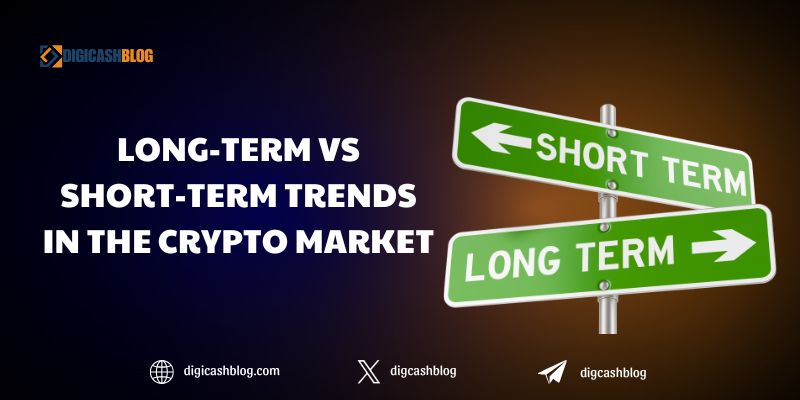Introduction to Crypto Market Trends in 2025
The cryptocurrency market, valued at $2.66 trillion in 2025, is characterized by its volatility and rapid evolution, driven by technological advancements, regulatory shifts, and market sentiment. Understanding long-term vs short-term trends in the crypto market for 2025 is crucial for investors and traders to align strategies with their goals. Long-term trends focus on structural shifts and fundamental growth, while short-term trends are driven by market dynamics and sentiment. This article explores these trends, their drivers, and how technical and on-chain analysis can guide decision-making in the crypto ecosystem.
Long-Term Trends in the Crypto Market
Long-term trends reflect structural changes and adoption patterns that shape the crypto market over years. In 2025, several key factors are driving sustained growth:
Institutional Adoption: Institutional investment, particularly through Bitcoin ETFs (e.g., BlackRock’s $15 billion in assets), is a cornerstone of long-term growth. Posts on X highlight sustained ETF inflows, signaling confidence in Bitcoin as a store of value.
Regulatory Clarity: Pro-crypto policies, such as the U.S. repeal of the IRS’s DeFi broker rule and the EU’s MiCA framework, foster mainstream adoption. South Africa’s 2025 exchange control regulations further integrate digital assets, boosting long-term investor confidence.
Technological Advancements: Layer 1 blockchains (e.g., Ethereum, Solana) and Layer 2 solutions (e.g., Arbitrum, Optimism) enhance scalability, reducing transaction costs and driving dApp adoption. DeFi’s projected $200 billion TVL and RWA tokenization’s $50 billion market by year-end underscore this trend.
On-Chain Metrics: On-chain analysis reveals long-term accumulation. For instance, Bitcoin’s HODL Waves show increasing unspent coins, indicating investor commitment, while Ethereum’s 1.2 million daily active addresses signal robust network growth.
Investment Strategy: Long-term investors use Moving Averages (MA), such as the 200-day SMA, to confirm bullish trends. A price above the 200-day SMA for Bitcoin, combined with rising on-chain transaction volume, supports a buy-and-hold strategy.

Short-Term Trends in the Crypto Market
Short-term trends are driven by immediate market dynamics, sentiment, and speculative activity, often lasting days to weeks:
Market Sentiment and Social Media: Platforms like X amplify short-term price movements. For example, memecoin pumps (e.g., Dogecoin) driven by community hype on X can cause rapid price spikes, followed by corrections.
Whale Activity: Large wallet movements, such as a $100 million Solana transfer to a cold wallet, can trigger short-term volatility. On-chain analysis tools like Glassnode track these moves, helping traders anticipate price swings.
Macroeconomic Events: Sudden events, like U.S. trade tariffs in Q1 2025 causing a Bitcoin price dip from $108,786, create short-term volatility, as noted in X discussions.
Speculative Trading: Altcoins and DeFi tokens experience short-term rallies driven by news (e.g., protocol upgrades). For instance, a Solana dApp launch can spark a temporary price surge.
Technical Analysis: Short-term traders rely on Exponential Moving Averages (EMA) (e.g., 12-day and 26-day EMAs) and volume analysis. A bullish 12-day EMA crossover for XRP with high trading volume signals a short-term buying opportunity.
Comparing Long-Term and Short-Term Trends
Time Horizon: Long-term trends focus on multi-year growth driven by adoption and infrastructure, while short-term trends capitalize on immediate market movements.
Risk and Reward: Long-term strategies (e.g., holding Bitcoin above its 200-day SMA) offer stability but lower returns, while short-term trades (e.g., scalping altcoins on 4-hour charts) are riskier but potentially more profitable.
Data Sources: Long-term trends rely on on-chain metrics (e.g., active addresses, HODL Waves), while short-term trends use volume analysis and technical indicators like RSI or Bollinger Bands.
Market Drivers: Long-term growth is driven by fundamentals (e.g., DeFi TVL, RWA tokenization), while short-term movements are influenced by sentiment and whale activity.
Leveraging Technical Analysis for Both Trends
Technical and on-chain tools bridge long-term and short-term strategies:
Moving Averages: Long-term investors use the 200-day SMA to confirm bullish trends, while short-term traders use 12-day/26-day EMA crossovers for quick entries. For example, a Golden Cross in Ethereum’s daily chart supports long-term holding, while a 12-day EMA crossover on a 4-hour chart signals a short-term trade.
Volume Analysis: High volume validates breakouts for both horizons. A Bitcoin breakout above resistance with spiking volume confirms a short-term rally, while sustained on-chain volume supports long-term growth.
Fibonacci Retracement: Long-term investors use Fibonacci levels (e.g., 61.8%) to identify support during pullbacks, while short-term traders use them for scalping opportunities.
On-Chain Analysis: Metrics like exchange outflows (e.g., $1 billion Bitcoin outflows in Q1 2025) signal long-term accumulation, while whale transactions drive short-term volatility.

Challenges in Navigating Crypto Trends
Volatility: Short-term price swings, like those triggered by tariffs in Q1 2025, challenge both strategies, requiring robust risk management.
Regulatory Uncertainty: While long-term clarity is improving, short-term regulatory news can cause sudden price drops, as seen with altcoins in restrictive regions.
Speculative Noise: Short-term memecoin pumps, amplified on X, can mislead traders, while long-term investors must filter hype to focus on fundamentals.
Data Reliability: Wash trading inflates exchange volume, necessitating on-chain analysis for accurate insights.
The long-term vs short-term trends in the crypto market for 2025 reflect a dynamic interplay of fundamentals and sentiment. Long-term trends, driven by institutional adoption, regulatory clarity, and technological advancements, favor stable growth in assets like Bitcoin and Ethereum. Short-term trends, fueled by whale activity and social media hype, offer high-risk, high-reward opportunities in altcoins and memecoins
